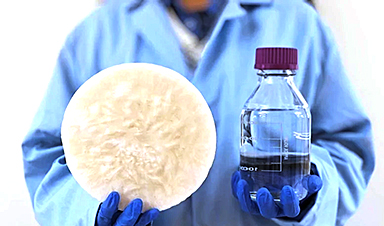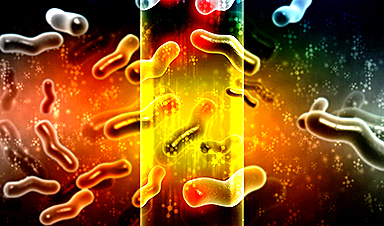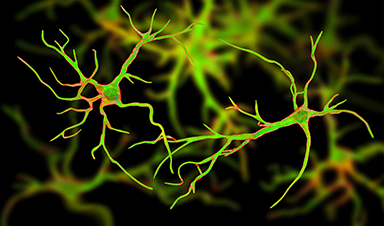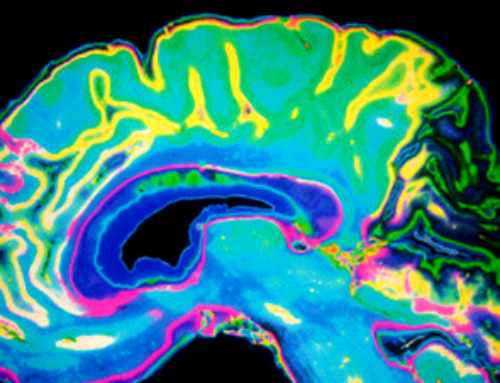UT Austin researchers have developed a biodegradable, biomass-based hydrogel that efficiently extracts drinkable water from the air, offering a scalable, sustainable solution for water access in off-grid communities, emergency relief, and agriculture.
Discarded food scraps, stray branches, seashells, and other natural materials serve as key ingredients in a new system developed by researchers at The University of Texas at Austin that can extract drinkable water from thin air.
This innovative system, called “molecularly functionalized biomass hydrogels,” transforms a wide range of natural products into sorbents—materials that absorb liquids. By pairing these sorbents with mild heat, the researchers can extract gallons of drinkable water from the atmosphere, even in arid conditions.
“With this breakthrough, we’ve created a universal molecular engineering strategy that allows diverse natural materials to be transformed into high-efficiency sorbents,” said Guihua Yu, a professor of materials science and mechanical engineering and Texas Materials Institute at UT Austin. “This opens up an entirely new way to think about sustainable water collection, marking a big step towards practical water harvesting systems for households and small community scale.”
In field tests, the researchers generated 14.19 liters (3.75 gallons) of clean water per kilogram of sorbent daily. Most sorbents can generate between 1 and 5 liters per kilogram per day.
The new research was published in Advanced Materials.
Turning Biomass into High-Efficiency Sorbents
This system represents a new way of designing sorbents, the researchers say. Instead of the traditional “select-and-combine” approach, which requires picking specific materials for specific functions, this general molecular strategy makes it possible to turn almost any biomass into an efficient water harvester.
Unlike existing synthetic sorbents, which use petrochemicals and generally require high energy inputs, the UT Austin team’s biomass-based hydrogel is biodegradable, scalable, and requires minimal energy to release water. The secret lies in a two-step molecular engineering process that imparts hygroscopic properties and thermoresponsive behavior to any biomass-based polysaccharide, such as cellulose, starch, or chitosan.
“At the end of the day, clean water access should be simple, sustainable, and scalable,” said Weixin Guan, a senior doctoral student and the study’s lead researcher. “This material gives us a way to tap into nature’s most abundant resources and make water from air—anytime, anywhere.”
The latest innovation is part of Yu’s years-long quest to develop solutions for people lacking access to clean drinking water. He’s developed water-generating hydrogels throughout his career, adapting them for the driest conditions. He recently created an injectable water filtration system, and he has applied his hydrogel technology to farming.
The research team is now working on scaling production and designing real-world device systems for commercialization, including portable water harvesters, self-sustaining irrigation systems, and emergency drinking water devices. Since the beginning, the researchers have focused on scalability and the ability to translate this research into solutions that can help people around the world.
“The biggest challenge in sustainable water harvesting is developing a solution that scales up efficiently and remains practical outside the lab,” said Yaxuan Zhao, a graduate researcher in Yu’s lab. “Since this hydrogel can be fabricated from widely available biomass and operates with minimal energy input, it has strong potential for large-scale production and deployment in off-grid communities, emergency relief efforts, and decentralized water systems.”
Reference: “Molecularly Functionalized Biomass Hydrogels for Sustainable Atmospheric Water Harvesting” by Weixin Guan, Yaxuan Zhao, Chuxin Lei, Yuyang Wang, Kai Wu and Guihua Yu, 13 February 2025, Advanced Materials.
DOI: 10.1002/adma.202420319
News
Researchers highlight five pathways through which microplastics can harm the brain
Microplastics could be fueling neurodegenerative diseases like Alzheimer's and Parkinson's, with a new study highlighting five ways microplastics can trigger inflammation and damage in the brain. More than 57 million people live with dementia, [...]
Tiny Metal Nanodots Obliterate Cancer Cells While Largely Sparing Healthy Tissue
Scientists have developed tiny metal-oxide particles that push cancer cells past their stress limits while sparing healthy tissue. An international team led by RMIT University has developed tiny particles called nanodots, crafted from a metallic compound, [...]
Gold Nanoclusters Could Supercharge Quantum Computers
Researchers found that gold “super atoms” can behave like the atoms in top-tier quantum systems—only far easier to scale. These tiny clusters can be customized at the molecular level, offering a powerful, tunable foundation [...]
A single shot of HPV vaccine may be enough to fight cervical cancer, study finds
WASHINGTON -- A single HPV vaccination appears just as effective as two doses at preventing the viral infection that causes cervical cancer, researchers reported Wednesday. HPV, or human papillomavirus, is very common and spread [...]
New technique overcomes technological barrier in 3D brain imaging
Scientists at the Swiss Light Source SLS have succeeded in mapping a piece of brain tissue in 3D at unprecedented resolution using X-rays, non-destructively. The breakthrough overcomes a long-standing technological barrier that had limited [...]
Scientists Uncover Hidden Blood Pattern in Long COVID
Researchers found persistent microclot and NET structures in Long COVID blood that may explain long-lasting symptoms. Researchers examining Long COVID have identified a structural connection between circulating microclots and neutrophil extracellular traps (NETs). The [...]
This Cellular Trick Helps Cancer Spread, but Could Also Stop It
Groups of normal cbiells can sense far into their surroundings, helping explain cancer cell migration. Understanding this ability could lead to new ways to limit tumor spread. The tale of the princess and the [...]
New mRNA therapy targets drug-resistant pneumonia
Bacteria that multiply on surfaces are a major headache in health care when they gain a foothold on, for example, implants or in catheters. Researchers at Chalmers University of Technology in Sweden have found [...]
Current Heart Health Guidelines Are Failing To Catch a Deadly Genetic Killer
New research reveals that standard screening misses most people with a common inherited cholesterol disorder. A Mayo Clinic study reports that current genetic screening guidelines overlook most people who have familial hypercholesterolemia, an inherited disorder that [...]
Scientists Identify the Evolutionary “Purpose” of Consciousness
Summary: Researchers at Ruhr University Bochum explore why consciousness evolved and why different species developed it in distinct ways. By comparing humans with birds, they show that complex awareness may arise through different neural architectures yet [...]
Novel mRNA therapy curbs antibiotic-resistant infections in preclinical lung models
Researchers at the Icahn School of Medicine at Mount Sinai and collaborators have reported early success with a novel mRNA-based therapy designed to combat antibiotic-resistant bacteria. The findings, published in Nature Biotechnology, show that in [...]
New skin-permeable polymer delivers insulin without needles
A breakthrough zwitterionic polymer slips through the skin’s toughest barriers, carrying insulin deep into tissue and normalizing blood sugar, offering patients a painless alternative to daily injections. A recent study published in the journal Nature examines [...]
Multifunctional Nanogels: A Breakthrough in Antibacterial Strategies
Antibiotic resistance is a growing concern - from human health to crop survival. A new study successfully uses nanogels to target and almost entirely inhibit the bacteria P. Aeruginosa. Recently published in Angewandte Chemie, the study [...]
Nanoflowers rejuvenate old and damaged human cells by replacing their mitochondria
Biomedical researchers at Texas A&M University may have discovered a way to stop or even reverse the decline of cellular energy production—a finding that could have revolutionary effects across medicine. Dr. Akhilesh K. Gaharwar [...]
The Stunning New Push to Protect the Invisible 99% of Life
Scientists worldwide have joined forces to build the first-ever roadmap for conserving Earth’s vast invisible majority—microbes. Their new IUCN Specialist Group reframes conservation by elevating microbial life to the same urgency as plants and [...]
Scientists Find a Way to Help the Brain Clear Alzheimer’s Plaques Naturally
Scientists have discovered that the brain may have a built-in way to fight Alzheimer’s. By activating a protein called Sox9, researchers were able to switch on star-shaped brain cells known as astrocytes and turn them into [...]





















